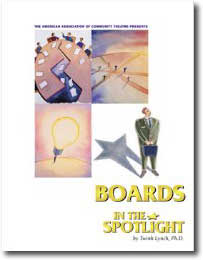Board Building
|
To fulfill your organization's strategic goals, you need a well-rounded, fully functional board, capable of taking on any challenge.
|
 |
How many kinds of boards are there? More than we can consider here, but there are broad categories, even though a single‑function board is a rarity.
- Some boards are hands‑on, day‑to‑day working groups, involved in every aspect of production and governance. Members are performers and technicians, well acquainted with the logistics of producing a show. This board is effective in a company where most of the revenue comes from ticket sales, not from donations or grants.
- Other boards focus primarily on public relations. Members may never have been on stage and have no desire to be. They may design and engage in fundraising activities, but usually are more concerned with promoting the company and its interests in the community. They operate on the theory that if people know who you are and what you're doing, they will support you. Such boards function best in a community where there is already widespread patronage of the arts.
- Some companies use their board as artistic advisors, setting policy for what kinds of shows the company will produce. In essence an advisory board, this group considers standards of their community and sets parameters within which the company can best operate. Such boards are often attached to groups with ethnic, religious or political concerns that will be addressed through their productions.
- Boards whose primary goal is to raise money for the company may have a general responsibility‑‑"Keep this company operating in the black"‑‑or be charged with specific goals, such as financing a new building.
- The majority of boards are administrative, policy‑making bodies. They set long‑term goals and implement plans to accomplish those goals. Included is some method of gauging the success of its efforts, and fundraising is often a part of this.
No matter what its makeup, a board must provide both strategic leadership and steady stewardship, with a focus on financial sustainability. AACT believes it is important to recognize and cultivate leadership skills within an organization in order for it to maintain its founding vision, while also adapting to changing needs.
 Exclusively from AACT: Boards in the Spotlight
Exclusively from AACT: Boards in the Spotlight
 Nationally-recognized community theatre consultant Twink Lynch, Ph.D., brings you the benefit of her 30-plus years of experience in helping non-profit boards.
Nationally-recognized community theatre consultant Twink Lynch, Ph.D., brings you the benefit of her 30-plus years of experience in helping non-profit boards.
Learn now to:
- Recruit & train the best possible board members
- Give direction to help them be effective on their own
- Transform them into successful fundraisers
- Build a cohesive & collaborative team
- Deal successfully with change and challenges
Check our online shop for order information
 General Resources
General Resources
- See the Governance menu at upper right for AACT resources. Those without an asterisk (*) are available to both members and non-members.
- The National Council of Nonprofits offers many helpful articles on key governance topics, including board member roles and responsibilities, conflicts of interest, ethics and accountability issues, and governance policies.
- BoardSource provides a library of free community resources, including assessing board performance, a board candidate rating form, and more.
 AACT-Member Resources
AACT-Member Resources
- See the Governance menu at upper right for AACT resources.
- Check out the many articles on boards & governance available in our Resource Library
- Seek ideas and guidance from other board members through the AACTList email discussion group or Resource Roster

